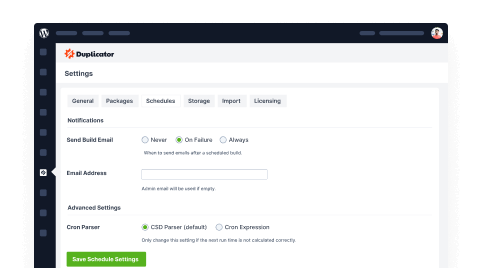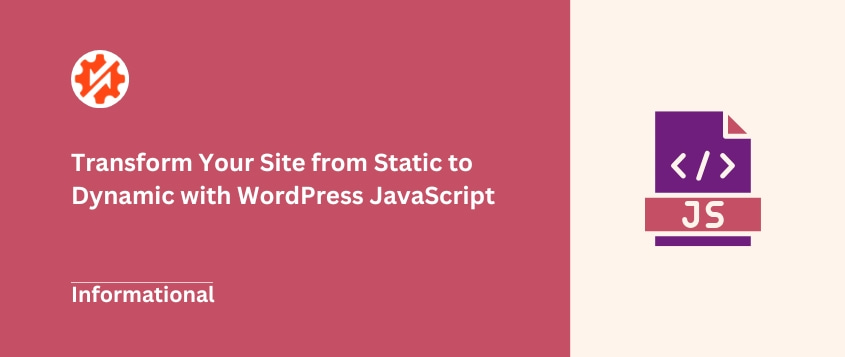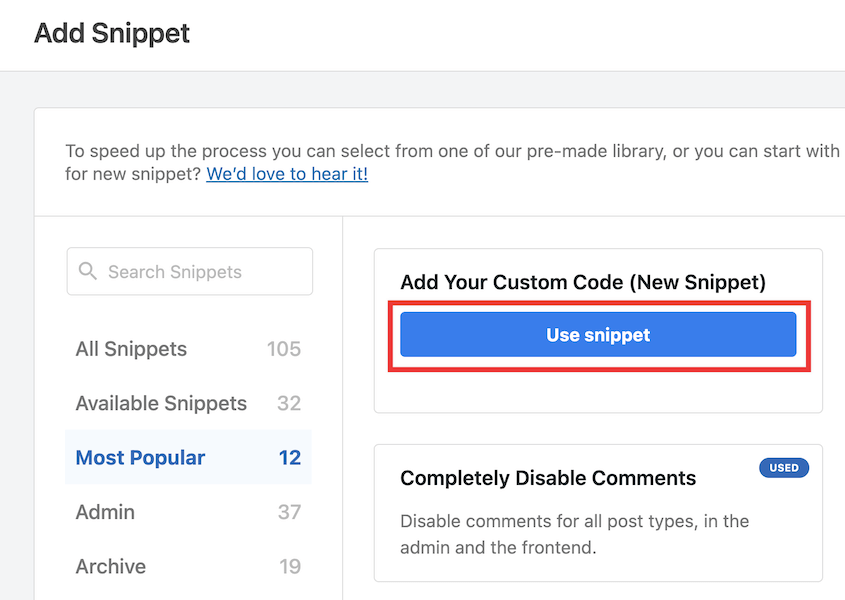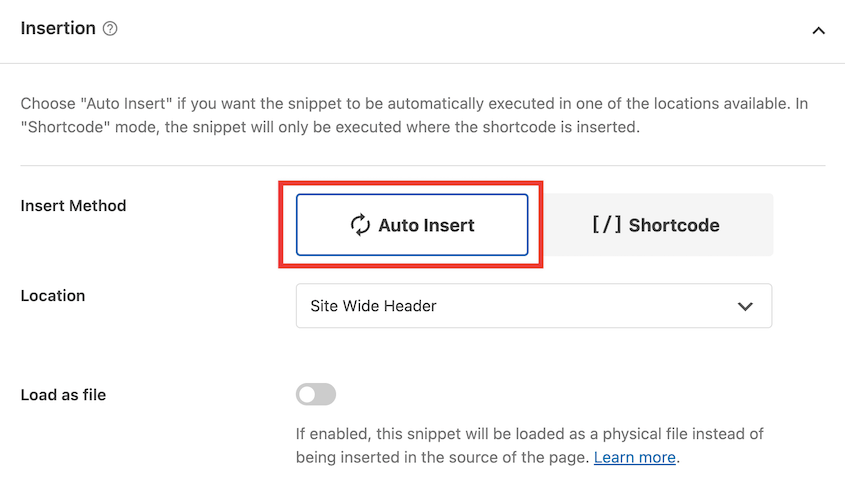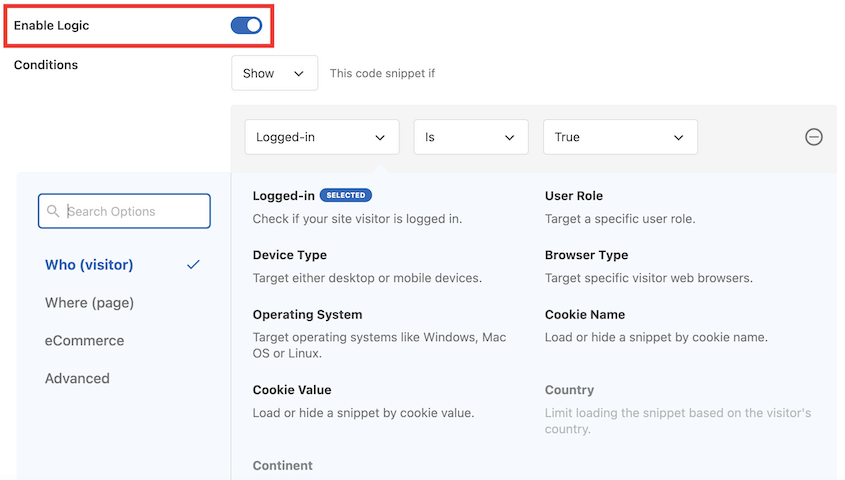Ever visited a website where elements move, change, or respond to your clicks without reloading the page? That’s JavaScript in action.
While WordPress is built on PHP, JavaScript has become essential for creating modern, interactive websites that users love.
Whether you’re looking to add simple animations or build complex features, JavaScript opens up a world of possibilities.
In this post, I’ll explain what JavaScript is and why you might want to start learning it. You’ll also find out how to add custom JavaScript in WordPress!
Table of Contents
What Is JavaScript?
JavaScript is a programming language that runs in your visitors’ browsers, not on your server.
When someone visits your WordPress site, the server processes PHP code and sends HTML and CSS to their browser. Then JavaScript takes over, allowing real-time interactions without sending more requests to the server.
Here are some common things JavaScript handles on WordPress sites:
- Showing or hiding content when a button is clicked
- Validating form fields before submission
- Loading new content without refreshing the page
- Creating animations and visual effects
- Updating parts of a page based on user input
Unlike PHP changes that require server processing, JavaScript can make your site feel responsive and app-like because it happens instantly in the user’s browser.
Why Learn WordPress JavaScript?
JavaScript skills have become increasingly valuable, and for good reason.
Adding JavaScript to your WordPress toolkit lets you create better user experiences by making your site feel faster and more responsive.
It can also solve front-end problems that PHP simply can’t address. While PHP handles server operations beautifully, it can’t directly respond to mouse movements or update content dynamically.
With JavaScript, you’ll be able to customize existing themes and plugins without completely rebuilding them. Often, a small JavaScript tweak can modify functionality without diving into complex PHP code.
Knowing JavaScript helps you stay relevant in WordPress development. With the block editor (Gutenberg) built on React (a JavaScript framework), JavaScript has become essential for serious WordPress developers.
You can also build custom solutions with JavaScript that plugins can’t provide. When you need something uniquely tailored to your site’s needs, JavaScript gives you the freedom to create it.
Where to Learn WordPress JavaScript
Start with core JavaScript fundamentals before diving into WordPress-specific applications. You wouldn’t build a house without understanding the materials, and the same applies here.
Good resources for JavaScript basics include:
- freeCodeCamp
- Mozilla Developer Network JavaScript tutorials
- Codecademy’s JavaScript course
Once you’ve grasped the fundamentals, move to WordPress-specific JavaScript resources.
The official WordPress Developer Handbook has sections dedicated to JavaScript. It’ll teach you proper script loading with wp_enqueue_script() and working with the WordPress JavaScript API.
Learn.wordpress.org offers workshops on JavaScript development. WPBeginner and CSS-Tricks both publish excellent WordPress JavaScript tutorials, too.
And here’s an extra (often overlooked) tip: see how quality themes and plugins use JavaScript. WordPress code is open source, giving you real-world examples to study.
How to Add Custom JavaScript to WordPress
There are several ways to add JavaScript to your WordPress site, each with different use cases. Let’s look at some common methods.
1. Use a JavaScript WordPress Plugin
For beginners, WordPress code plugins provide the safest entry point. Manually adding JavaScript code can be difficult, and I’d only recommend it to developers.
WPCode (formerly Insert Headers and Footers) lets you add JavaScript snippets without touching theme files. This is a perfect example of a WordPress JavaScript plugin that simplifies code management.
Here’s some benefits of using WPCode to add JavaScript:
- Your code remains intact during theme updates, unlike direct file editing.
- You can easily disable scripts without removing code when troubleshooting.
- The plugin handles proper code placement in either the header or footer.
I personally use this method when testing new scripts or implementing quick fixes on client sites. It provides a safety net while still getting the job done.
To get started, install and activate WPCode. Then, add a new custom snippet.
For the Code Type, choose JavaScript Snippet. Enter your JavaScript into the code editor.
Save the JavaScript code snippet. If you want WPCode to handle placement for you, scroll down to Insertion and click Auto Insert.
However, feel free to change the location to a specific post or page.
WPCode also gives you options for conditional loading (showing scripts only on certain pages), which helps with performance optimization. All you’ll need to do is enable the logic and choose the conditions.
If you’re ready to activate the snippet, scroll back to the top and turn on the toggle switch.
Hit Update and you’re done! You just added custom JavaScript without needing any development experience.
2. Edit Your Theme’s functions.php File
The functions.php file is where WordPress handles its programmatic functionality, including script management.
Adding JavaScript through your WordPress theme’s functions file gives you more control and eliminates the need for extra plugins.
However, you should NEVER edit your parent theme’s functions.php file directly. These changes will be lost when the theme updates.
Always use a child theme for any code modifications. This is essential for maintaining your customizations long-term.
Once you have a child theme activated, go to Appearance » Theme File Editor and open the functions.php file.
WordPress provides a standardized function for adding JavaScript properly: wp_enqueue_script(). This isn’t just a suggestion—it’s the WordPress way of managing scripts.
Using this method helps:
- Prevent conflicts between different scripts
- Manage loading order when one script depends on another
- Handle version control for browser caching
- Optimize placement in your page’s HTML
Here’s a basic example of how to add custom JavaScript to your WordPress site:
function my_custom_scripts() {
wp_enqueue_script(
'my-custom-script', // Unique handle
get_stylesheet_directory_uri() . '/js/my-script.js', // File path
array('jquery'), // Dependencies
'1.0', // Version number
true // Load in footer (recommended)
);
}
add_action('wp_enqueue_scripts', 'my_custom_scripts');
The parameters break down as:
- A unique name (handle) for your script
- The location of your JavaScript file
- Any dependencies your script needs
- Version number (helps with browser caching)
- Whether to place in the footer (true) or header (false)
Loading scripts in the footer (parameter #5 set to true) improves page loading performance by letting visible content load first. Using WordPress hooks like wp_enqueue_scripts ensures your code runs at exactly the right time in the page loading process.
JavaScript Tips and Troubleshooting
Even experienced developers encounter issues when adding JavaScript to WordPress. Here are some practical tips to avoid common problems.
Always use wp_enqueue_script() instead of hardcoding <script> tags. This prevents conflicts with other plugins and themes.
Check your browser’s developer tools for JavaScript errors. If you find your WordPress JavaScript not working as expected, the console will usually provide clues about what’s going wrong.
When scripts aren’t working, verify that dependencies are loading correctly. If your code needs jQuery but loads before it, things will break.
Place scripts in the footer whenever possible by setting the last parameter of wp_enqueue_script() to true. This improves page load performance and prevents scripts from trying to manipulate elements that haven’t loaded yet.
Wrap your JavaScript in immediately invoked function expressions (IIFE) to avoid conflicts with other scripts:
(function($) {
// Your code here
$('.my-button').click(function() {
// Button click code
});
})(jQuery);
Use unique variable and function names to prevent collisions with other scripts. Prefixing with your theme or plugin name helps.
Remember that WordPress includes jQuery in “no-conflict” mode. Always use jQuery() instead of $() unless you’re wrapping your code as shown in the IIFE example above.
WordPress JavaScript Examples
JavaScript can do a ton of cool stuff for your WordPress site. Here are just a few examples to show you what’s possible.
Fade Page Transitions
Remember when I said JavaScript can add animations to your website? One thing you can do is make your page fade away when someone clicks on a link.
WPCode has a pre-made JavaScript code snippet for this! Simply search for Fading Page Transitions in the Code Snippets library.
Or, paste this code into a new custom snippet:
document.addEventListener("DOMContentLoaded", function() {
// Create and insert CSS styles for fade-in and fade-out
const style = document.createElement('style');
style.innerHTML = `
.fade-out {
opacity: 0;
transition: opacity 0.5s ease-in-out;
}
.fade-in {
opacity: 1;
transition: opacity 0.5s ease-in-out;
}
`;
document.head.appendChild(style);
// Apply the fade-in effect on page load
document.body.classList.add('fade-in');
// Attach event listeners to all internal links for the fade-out effect
document.querySelectorAll('a').forEach(anchor => {
anchor.addEventListener('click', function(event) {
if (anchor.hostname !== window.location.hostname) return;
event.preventDefault();
const target = this.href;
document.body.classList.remove('fade-in');
document.body.classList.add('fade-out');
setTimeout(function() {
window.location.href = target;
}, 500); // Match this duration with the CSS transition time
});
});
});
Disable Content Copying
If you need to protect your premium content from easy copying, you can use this script:
document.addEventListener("contextmenu", (evt) => {
evt.preventDefault();
}, false);
document.addEventListener("copy", (evt) => {
evt.clipboardData.setData("text/plain", "You must pay a premium subscription to copy our content");
evt.preventDefault();
}, false);
Another feature you can add to your WordPress website with JavaScript is smooth scrolling. This web effect uses scroll actions to create a much more pleasant navigation experience for users.
Here’s the JavaScript for smooth scrolling:
document.addEventListener('click', function(e) {
// Check if the clicked element is an anchor with href starting with '#'
if (e.target.tagName === 'A' && e.target.getAttribute('href') && e.target.getAttribute('href').startsWith('#')) {
e.preventDefault();
const targetId = e.target.getAttribute('href').slice(1); // Remove the '#' from the href
const targetElement = document.getElementById(targetId);
if (targetElement) {
targetElement.scrollIntoView({
behavior: 'smooth'
});
}
}
});
Frequently Asked Questions (FAQs)
Does WordPress use PHP or JavaScript?
WordPress uses both PHP and JavaScript, but for different purposes. PHP powers the server-side operations—the content management system, database interactions, and most of the WordPress core functionality. When you save a post or change settings, PHP handles those operations.
JavaScript handles client-side interactions—what happens in the visitor’s browser after the page loads. This includes animations, interactive elements, real-time validation, and dynamic content changes without page reloads.
Modern WordPress development, especially with the block editor (Gutenberg), increasingly relies on both languages working together.
What is replacing JavaScript?
Nothing is directly replacing JavaScript. As the only native programming language supported by all web browsers, JavaScript remains fundamental to web development.
How can I add JavaScript to WordPress without a plugin?
The most common plugin-free method to add JavaScript to WordPress is through your child theme’s functions.php file using WordPress’s wp_enqueue_script() function. For one-off cases, you could also use a page builder’s custom code feature if your theme provides one.
Remember that avoiding plugins isn’t always better—a well-maintained plugin often handles edge cases and updates better than custom code.
Can you use JavaScript to build a website?
Yes, JavaScript can be used to build entire websites and web applications, especially with modern frameworks like React, Vue, or Angular.
In WordPress specifically, JavaScript enhances the existing PHP/HTML/CSS foundation rather than replacing it. You’re adding JavaScript functionality to a WordPress core that’s primarily PHP-based.
For example, the WordPress block editor (Gutenberg) is built with React (a JavaScript framework) but still operates within the PHP-based WordPress ecosystem.
How do I add JavaScript to a specific WordPress page?
The easiest way to add JavaScript to WordPress pages is with WPCode. Add a new custom JavaScript snippet. Scroll down to Location and expand the dropdown menu. Select Page-Specific, and then decide where you want your JavaScript to apply.
This approach works equally well for both WordPress pages and posts, giving you granular control over where your scripts run.
Final Thoughts
Adding JavaScript to your WordPress toolkit dramatically extends what you can do with your website.
From simple interface enhancements to complex interactive features, JavaScript bridges the gap between static content and dynamic user experiences.
Always remember that mistakes happen. Before adding JavaScript or making any significant changes, create a complete backup of your site.
Duplicator Pro makes it easy to back up your website on a schedule. Plus, it gives you simple restore options if something goes wrong. Try it out today!
Your JavaScript journey with WordPress doesn’t end here — it’s a continuously evolving field as both JavaScript and WordPress grow. Investing in learning JavaScript will significantly benefit your own projects and client work!
While you’re here, I think you’ll like these other WordPress guides:
Joella is a writer with years of experience in WordPress. At Duplicator, she specializes in site maintenance — from basic backups to large-scale migrations. Her ultimate goal is to make sure your WordPress website is safe and ready for growth.

